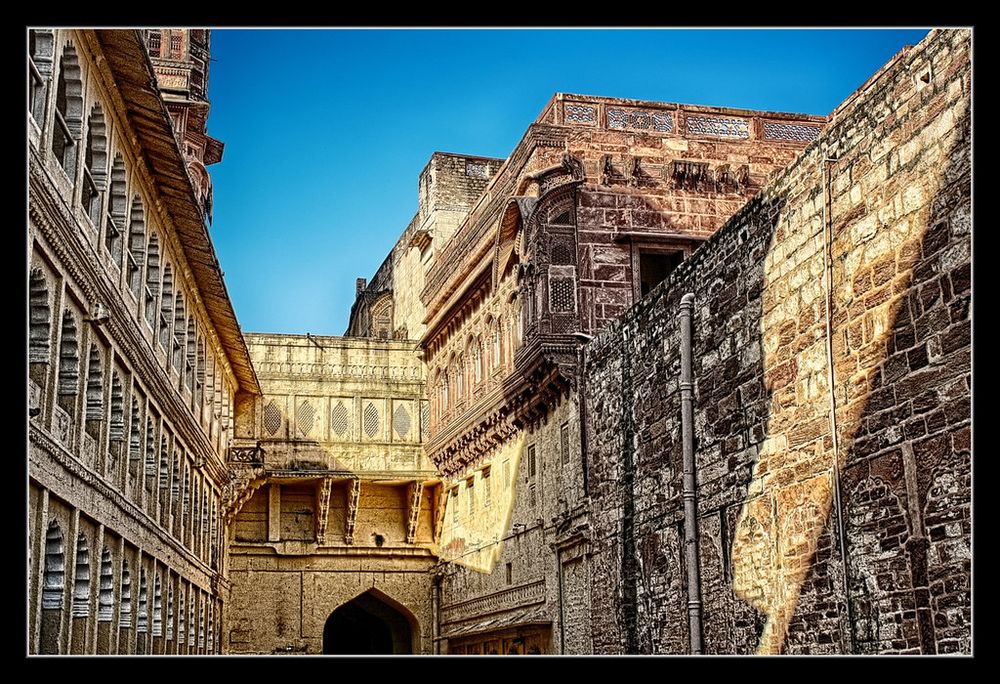In Mehrangarh fort of Jodhpur, Rajasthan, murals lend insight into the infernal past of Hindu traditions. Its imprinted walls and resounding zenanas continue to tell legends of yore. One such element of conversation is the 15 handprints on the innermost gate of the fort, left by women that once inhabited the fort.

Photo: Michael Foley/Flickr
The Sati Hands
Sati is a dated Hindu tradition that called for widowed women to give up their lives at the funeral pyre of their husband. Hundreds of wives and concubines would jump into the funerary fires, or get forced in in the name of tradition. It was an act that horrified the British, which is why they banned it in 1829. But sati was rooted too deeply in the land of India to be abolished easily. It took a publicised sati death in 1987 for the Indian government to formally create the Commission of Sati (Prevention) Act.
But one instance of sati was immortalised forever in Mehrangarh fort back in 1843. The structure has seven gates, and the innermost of these gates is called the Loha Pol or Iron Gate. 15 tiny handprints remain imprinted on this gate till date. The handprints were left when Maharaja Man Singh passed away. Called the sati hands, they were imprinted by the spouses of the Maharaja who jumped onto the funeral pyre after decorating the crimson wall as a memorial.

Photo: Manfred Sommer/Flickr
But the prints allude to only a chapter in the tumultuous history of the fort. Before this incident, six spouses and 58 mistresses of Maharaja Ajit Singh had also died in the act of sati in 1731. In fact, the foundation of the citadel had been murky from the beginning, and heralded one mishap after the other on its grounds.
A Bloody Foundation
In the 15th century, Rao Jodha of the Rathores of Marwar decided to build a humongous fort atop a hill that offered natural defences. This fort was to be named Mehrangarh fort and the town that birthed at its base was Jodhpur. But for the construction of the fort the hill had to be cleared of its current inhabitants—an act that was meekly accepted by all except one. Chidiyawaale Baba—a saint who took pleasure in feeding birds there—cursed the king in anger that his kingdom would suffer from drought after drought if the fort was erected.
There was only one way to appease the saint, and the monarch was not going to let it go. To reverse the curse, a local from the kingdom was asked to lay down his life at the behest of the saint. This man was Rajaram Meghwal, who was buried alive amid brick and mortar of the fort in 1459. His sandstone memorial was built on the fort grounds and his family continued to be supported by the state for generations past.

Photo: Daniel Mennerich/Flickr

Photo: Daniel Mennerich/Flickr
But fate took another turn towards morbidity here. The 120ft rampart erected 400ft above the valley caused death in other ways: tourists slipped and fell off the monument, Maharaja Rao Ganga perished here under the influence of opium, and hundreds died in a 2008 stampede at the Chamunda Devi temple of the fort precinct.
Yet many others continue to visit the fort for its majestic built. The Moti Mahal and Phool Mahal sparkle with their mirror-laden walls. A gallery and an armoury display the finest of Marwari colours and arms. There are also palanquins, leisure rooms and a museum to look out for, most of which date back to 17th century construction. But nothing matches the sati handprints that welcome you into a world of mishap, and the Meghwal memorial that testifies to India’s topsy turvy belief systems.
References
# Atlas Obscura
# Times Travel
# FirstPost
# Mehrangarh.org












Was lucky enough to visit this place in 2003.... a must visit place... nice writeup n info...
ReplyDelete